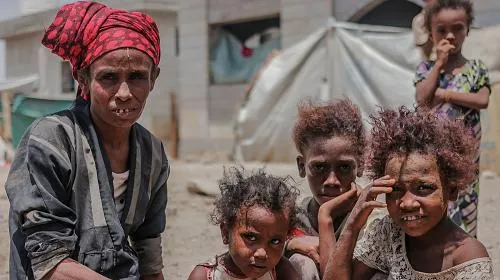March 26 marks four years since the escalation of conflict in Yemen in 2015. In four years, the country has seen the worst cholera outbreak in history, a declaration of famine, and a crippled economy. There have been almost 20,000 airstrikes, over 70,000 people have died, 4 million have had to leave their homes behind, and now 80% of the population requires humanitarian assistance – an increase of 10% since 2018.
“We are in a position right now to say that things cannot get worse,” says Johan Mooij, CARE Yemen’s Country Director. “A beautiful country has been destroyed by four years of fighting and economic collapse. Ten million people are at real risk of famine; half of health services don’t function; people are bombed, shelled and hit by landmines every day.”
After four years of fighting and economic decline most people in Yemen have become reliant on humanitarian aid to survive. Without the food, water and healthcare provided by humanitarian agencies, the 65,000 people currently living in famine would be at least a quarter of a million, and cholera and disease would be rife. 600,000 people have lost jobs since 2015, with the agricultural sector particularly badly affected.
“Millions of families have lost their livelihoods,” says Mooij. “And women are having to fend for their families’ survival, having lost husbands and male relatives to the fighting. Not only are they grieving for the people they loved who have been killed or who have disappeared, but they also have to find ways to feed their children and make sure they have clean water to drink and medicine if they are sick. This kind of situation is almost impossible to imagine.”
Ateqah is a 33-year-old mother living in Jabal Yazid district of Amran governorate in the north of Yemen. Her husband left and she has not seen him since – she doesn’t know whether he is alive or dead. She lives with her two sons and one daughter and their 70-year-old grandfather. “I couldn’t find anyone to help take care of my family,” she says. “I searched for work but I don’t know how to find it. Some of my neighbors helped us and provided us with two rooms and a toilet – they give us some food and water every day. Every day I go to collect water from the well. We live here with nothing. God only knows our situation.”
Women often have a triple burden of providing income and food for families, as well as suffering from domestic abuse. There has been an increase in gender-based violence and women often have nowhere to turn, as protective societal structures collapse. There are only six women’s shelters in the whole of Yemen, and UNFPA estimates that there are 120,000 women and girls at risk of violence.
Samer lives with her husband, father-in-law, daughter and son in a small village 5 miles away from the Yemeni capital city of Sana’a. “One day my husband was starving,” says Samer. “I could not bake anything because I was suffering from a high fever. My husband’s hunger made him extremely angry and he beat me nearly to death.” Samer survived, but there are many women who face this kind of abuse on a daily basis.
“CARE is reaching around one million people per month,” says Mooij. “We cover needs across twelve governorates in Yemen. As well as providing humanitarian assistance and protection, we implement women’s and youth economic empowerment projects, helping people to generate income and giving them dignity and hope for the future. But despite our best efforts, if this war continues the people of Yemen will not see an end to their suffering. We desperately need a peaceful end to this deadly conflict, and we call on the international community to do everything in their power to ensure this happens.”
MEDIA CONTACTS:
Nicole Harris, 404-735-0871 nharris@care.org
Brian Feagans, 404-979-9453 bfeagans@care.org

